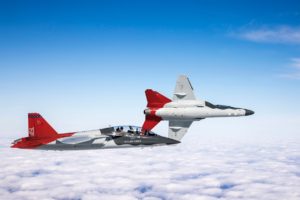ST. LOUIS—Boeing [BA] continues to buy down risk and get through key development milestones with the Air Force’s new T-7A pilot training system and the company and its teammate Saab are aiming to start production of the first test aircraft later in 2020 under the development contract, Boeing officials said here on Monday.
Boeing in September 2018 won a $9.2 billion contract to develop and produce the Air Force T-X pilot trainer, which is now called the T-7A Red Hawk, and will deliver 351 jets and 46 simulation systems by 2034.
During the T-X competition, which pitted the Boeing-Saab team against teams from Lockheed Martin
[LMT] and Leonardo DRS, the Boeing team built two aircraft based on a clean-sheet design to demonstrate the maturity and performance requirements. So far, the two aircraft have combined for about 140 test flights, demonstrating that the single-engine T-7A is meeting requirements, Paul Niewald, chief engineer for the program, said during a briefing for reporters at Boeing’s defense segment facilities adjacent to St. Louis Lambert International Airport.
Some of the flights have included high-speed, low-altitude testing, Niewald said.
The aircraft portion of the program in September successfully completed preliminary and critical design reviews, Niewald said.
“The reviews demonstrated that the detailed designs are complete and meet requirements and that systems, subsystems, software and components are ready for fabrication, coding, integration and assembly,” he said.
“I would say we bought down a lot of risk pre-contract by the design and development of the first two jets and so it’s evident in we’re flying them right now to show compliance to requirements,” Niewald said. “So that’s bought down that risk and provides a unique development program where we are updating the design for some of the things that were deferred or requirements that came later as we were already in the design of those two aircraft as well as we’re into the flight testing phase at the same time.”
Niewald said the two test aircraft allow Boeing and Saab to shorten the engineering and manufacturing development (EMD) phase of the program, allowing the team to test things like flight science, flying qualities, propulsion integration, and performance.
Deliveries of five flight-test aircraft and one static and full-fatigue test article are planned by the end of 2021 under the EMD portion of the T-7A contract. Testing for structural integrity, loads and flutter will occur with the EMD test jets, Niewald said.
The EMD test aircraft, including the static and fatigue test article, will be delivered by the end of 2021. The first low rate production aircraft are slated to be delivered in 2023 and initial operating capability remains on track for 2024.
At peak production, Boeing and Saab plan to build 60 T-7As annually.
Boeing sees the T-7A as a franchise program that will go well beyond the 351 aircraft for the Air Force. The T-7A has generated interest from air forces worldwide and Boeing expects demand for the aircraft not only as a trainer but as a light attack platform and aggressor aircraft for adversary training.
From design to production of the two existing test aircraft took just 36 months, which Boeing attributes in part to the application of model-based engineering and design efforts, including the use of virtual reality.
“On T-7, or T-X, we’re doing that work at about 70 percent less of comparable efforts,” Shelley Lavender, Boeing’s senior executive for its St. Louis operations and senior vice president of the Strike, Surveillance and Mobility portion of its defense segment, said during one media briefing. “So significantly less headcount to do comparable work than traditional ways.”
The model-based engineering is helping with the build portion of the program as well, Lavender said, saying “It’s almost like snap together toys.” The company has shown that it can do a join of airframe components in less than 30 minutes versus 24 hours for a legacy aircraft, she said.
Niewald said in his presentation that program is showing a 75 percent increase in first-time quality.
Lavender highlighted the rarity of a program that went through its critical design review at the same time it was conducting test flights.
“We’ve hit every major milestone on the program,” she said.
The use of digital engineering also strengthened the computational fluid dynamics-based models of the aircraft, which resulted in the need in few wind tunnel tests to prove out the design, Lavender said.
She also said that the program is “proving out and testing out 1,200 technical manuals using virtual reality,” demonstrating the use of mode-based engineering into build and sustainment portions of the T-7 program.
In addition to the aircraft, Boeing is also developing the simulation components, including cockpit simulator, and coursework that is part of the larger T-7A training system.
Earlier this year, the Ground-Based Training System component of the program completed the preliminary design review and is expected to undergo the critical design review in about a month.
The preliminary design review was an opportunity to “assess readiness to proceed into detailed design and to demonstrate that the preliminary designs can meet all system performance requirements,” Boeing said. “The upcoming CDR will assess the detailed designs to ensure all requirements are satisfied, interfaces are well designed, the team is ready to move into device procurement, assembly and integration phase.”
